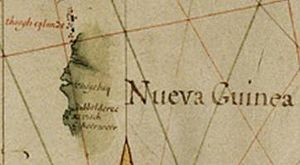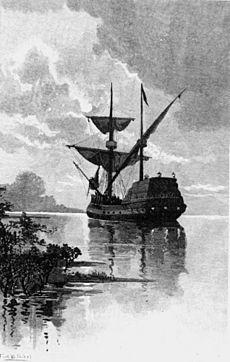Willem Janszoon facts for kids
Quick facts for kids
Willem Janszoon
|
|
|---|---|
| Born | c. 1570 |
| Died | c. 1630 (aged around 60) |
| Other names |
|
| Occupation | Navigator and colonial governor |
| Known for | European discovery of Australia |
Willem Janszoon (born around 1570, died around 1630) was a Dutch explorer and leader. He worked in the Dutch East Indies (which is now Indonesia) from 1603 to 1611 and again from 1612 to 1616. He even served as a governor of Fort Henricus on the island of Solor.
During his journey in 1605–1606, Janszoon and his crew became the first Europeans known to have seen and landed on the coast of Australia. His name is sometimes shortened to Willem Jansz. This was a common way to shorten names back then.
Contents
Early Life and Voyages
Willem Janszoon was born around 1570. We don't know much about his early life or his parents.
Janszoon first started working for a company that later became the Dutch East India Company (VOC) in 1598. He was a mate (an officer) on a ship called Hollandia. This ship was part of a big fleet sent by the Dutch to the Dutch East Indies.
Around 1600, he became a father to a son named Jan Willemsz. After that, he sailed again on May 5, 1601, to the East Indies as the master of a ship called Lam.
Janszoon left the Netherlands for the East Indies for the third time on December 18, 1603. He was the captain of the ship Duyfken (which means 'Little Dove'). This ship was part of a large fleet. While the other ships stayed in Java, Janszoon was sent to find new places for trade, especially in "the great land of New Guinea and other East and Southlands."
Discovering Australia
First Trip to Australia
On November 18, 1605, the ship Duyfken sailed from Bantam (in Indonesia) towards the coast of western New Guinea. Janszoon then sailed across the eastern part of the Arafura Sea into the Gulf of Carpentaria. He didn't know that Torres Strait existed at the time. The Duyfken was actually in Torres Strait in February 1606, just a few months before another explorer, Luís Vaz de Torres, sailed through it.
On February 26, 1606, Janszoon landed at the Pennefather River on the western side of Cape York in Queensland, Australia. This was near where the town of Weipa is today. This moment marks the first time Europeans are known to have landed on the Australian continent. Janszoon mapped about 320 kilometers (200 miles) of the coastline. He thought this land was just a southern part of New Guinea.
However, the land was swampy, and the local people were not friendly. Ten of his men were killed during different trips ashore. Because of this, Janszoon decided to turn back. He named the place where he turned around Kaap Keerweer, which means 'Cape Return'. He arrived back in Bantam in June 1606. He called the land he found Nieu Zelant or Nieu Zeelandt, after a Dutch province. But this name was not used for Australia. Later, Dutch mapmakers used it for New Zealand.
In 1607, Janszoon was sent to Ambon and Banda. In 1611, he went back to the Netherlands. He still believed that the southern coast of New Guinea was connected to the land he had sailed along. Because of this, Dutch maps showed this mistake for many years.
Second Trip to Australia
Janszoon later reported that on July 31, 1618, he landed on an island. He described it as being about 22 miles long and 240 miles south-southeast of the Sunda Strait. People generally believe he was describing the peninsula from Point Cloates to North West Cape on the coast of Western Australia. Janszoon thought it was an island, but he didn't sail all the way around it to be sure.
A Leader and Governor

Around 1617–1618, Janszoon was back in the Netherlands. He was chosen to be a member of the Council of the Indies, which was an important governing group. He also served as an admiral, leading the Dutch defense fleet.
In 1619, Janszoon was given a gold chain worth 1,000 guilders (a lot of money back then!). He received this award for helping to capture four ships from the British East India Company. These British ships had helped the Javanese people defend their town of Jakarta against the Dutch.
In 1620, he was one of the people who talked with the English to make agreements. They sailed together to Manila to stop Chinese traders from dealing with the Spanish. Janszoon became a vice-admiral and then an admiral the next year.
Near the end of his life, Janszoon was the governor of Banda from 1623 to 1627. He returned to Batavia (now Jakarta) in June 1627. Soon after, he led a fleet of eight ships on a diplomatic mission to India. On December 4, 1628, he sailed back to Holland. On July 16, 1629, he gave a report about the state of the Indies in The Hague. He was probably around sixty years old by then and ready to retire after a very busy and successful career serving his country. We don't know exactly when he died, but it's thought to have been in 1630.
How We Know About Him
The original diary and logbook from Janszoon’s 1606 voyage have been lost. However, the Duyfken chart, which shows where the ship first landed in Australia, was saved. This chart was still in Amsterdam when Hessel Gerritszoon made his map of the Pacific Ocean in 1622. He used the Duyfken geography on his map, making it the first map to show any part of Australia.
A copy of the chart was made around 1670. This copy eventually ended up in the Imperial Library in Vienna and was forgotten for 200 years. The map is part of the Atlas Blaeu Van der Hem, which was brought to Vienna in 1730. The information from his charts was also used to create large marble and copper maps of the hemispheres on the floor of The Citizens' Hall in the Royal Palace in Amsterdam.
See also
 In Spanish: Willem Janszoon para niños
In Spanish: Willem Janszoon para niños


